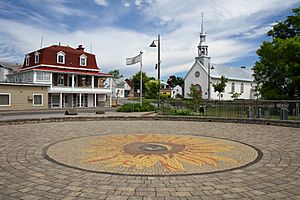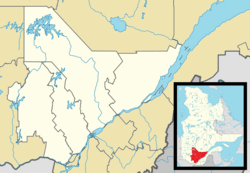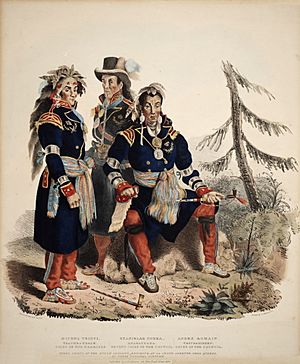Wendake facts for kids
Quick facts for kids
Wendake
|
||
|---|---|---|

The Place de la nation huronne-wendat in Wendake
|
||
|
||

Location of Wendake within the Quebec equivalent territory
|
||
| Country | Canada | |
| Province | Quebec | |
| Equivalent territory | Quebec | |
| First Nation | Huron-Wendat | |
| Area | ||
| • Total | 1.74 km2 (0.67 sq mi) | |
| Population
(2021)
|
||
| • Total | 2,200 | |
| Time zone | UTC−05:00 (EST) | |
| • Summer (DST) | UTC−04:00 (EDT) | |
| Postal code |
G0A 4V0
|
|
| Area code(s) | 418 and 581 | |
Wendake is a special place in Quebec, Canada. It is home to the Huron-Wendat Nation. Wendake is actually made up of two "urban reserves" called Wendake 7 and Wendake 7A. These areas are completely surrounded by Quebec City. They are like a small, independent community within a big city.
The Huron-Wendat people are one of the Seven Nations of Canada. Long ago, this settlement was known by other names like Village-des-Hurons (Huron Village) or (Jeune)-Lorette (New Lorette).
Scientists who study old things, called archeologists, have found large villages from the 1500s. These villages were north of Lake Ontario. This is where they believe the Wendat people first came together as a distinct group. Later, they moved south to the Georgian Bay area. The Wendat people spoke a language similar to other Iroquoian languages.
Contents
History of the Huron-Wendat People
Archeologists have found ancient villages from the 1500s in Ontario. These sites, like the Mantle Site, show that the Wendat people lived there. Experts believe this is where the Wendat group first formed. They later moved to the Georgian Bay area. This is where they first met Europeans in the 1600s.
Before the mid-1600s, the Wendat people lived in a huge area. This land stretched from what is now Detroit to parts of Ontario and Quebec. They hunted and trapped animals across this large territory. This included areas in the Laurentian Mountains.
Challenges and Changes
Between 1634 and 1650, the Wendat people faced many challenges. Their large group, called the Wyandot Confederation, broke apart. Many people died from new diseases brought by Europeans. The Wendat people had no natural protection against these illnesses.
It is thought that about 20,000 to 30,000 Wendat people lived in 1634. By 1650, only a few hundred were left. Wars also caused many deaths. The Iroquois Confederacy attacked them from the south. The Iroquois wanted to control hunting grounds and the fur trade.
Some Wendat people joined the Iroquois Confederacy. The survivors in Canada split into two groups. These were the Great-Lake Wyandot and the Huron-Wendat. The Huron-Wendat are the ancestors of the people living in Wendake today.
Finding a New Home
After these difficult times, about 300 Wendat people began a period of moving around. They lived in six different places in Quebec. Finally, in 1697, they settled permanently in the village of Lorette.
Their journey started on Île d'Orléans in 1651. Then they moved to Quebec City in 1668. After that, they lived temporarily in Beauport, Notre Dame de Foy, and L'Ancienne-Lorette. In 1673, they moved to New Lorette, which is now part of Wendake.
Wendake Today
According to the 2016 Canadian census, about 2,135 people live in the two reserves of Wendake. The Huron-Wendat Nation has over 4,300 registered members in total. Most of these members live outside the reserve.
Wendake 7 covers an area of about 1.33 square kilometers. Wendake 7A is about 2.45 square kilometers. Together, they make up about 3.78 square kilometers.
As of 2021, the leader of the Huron-Wendat Nation is Rémy Vincent. He is called the Grand Chief. Other important leaders before him include Konrad Sioui and Max Gros-Louis.
The Huron people used to call their original homeland Wendake. This was south of Georgian Bay in Ontario. A very large Huron-Wendat settlement from the 1400s was found there. This discovery helps experts understand where the Wendat people first developed.
Other groups of Wendat and Petun people formed the Wyandot. They moved south to what is now Michigan. Later, they were forced to move west of the Mississippi River. They ended up in Indian Territory in Kansas and Oklahoma.
In the United States, one Wyandot tribe is officially recognized by the government. This is the Wyandotte Nation of Oklahoma. Other groups, like the Wyandot Nation of Kansas, are not officially recognized. In 1999, these nations joined the modern Wendat Confederacy. They promised to help each other and work together in peace.
Images for kids
-
Old Wendake Historic District National Historic Site of Canada
See also
 In Spanish: Wendake para niños
In Spanish: Wendake para niños






